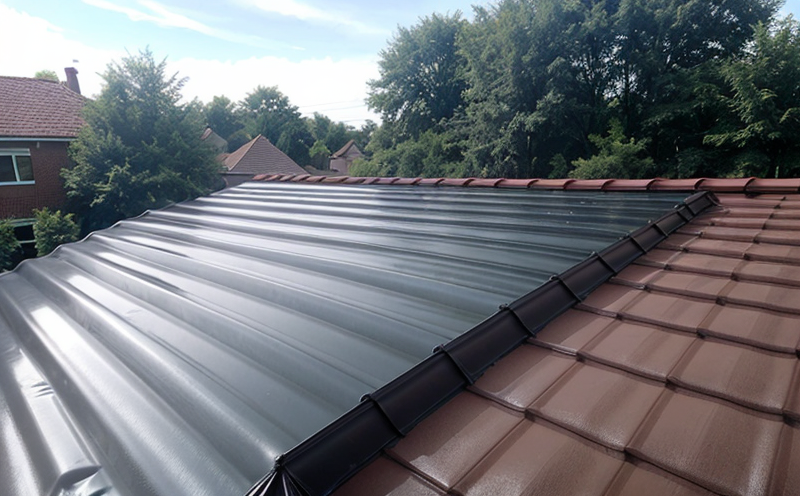ASTM D3462 Asphalt Shingle Dimensional Stability Testing
The asphalt shingle dimensional stability testing as per ASTM D3462 is a critical process for ensuring the quality and durability of roofing materials. This test measures the change in dimensions of an asphalt shingle under conditions that simulate real-world stresses, such as temperature variations and moisture exposure. The primary goal of this test is to evaluate how well the shingles maintain their size and shape over time, which directly impacts their performance and longevity on a building’s roof.
The testing procedure involves placing specimens in an environmental chamber designed to replicate extreme weather conditions. These chambers can simulate temperatures ranging from -20°C to 65°C (0°F to 150°F) with humidity levels up to 95% relative humidity. The specimens are exposed to these conditions for a specified duration, usually between 48 and 72 hours.
The ASTM D3462 standard specifies that the dimensional change of each specimen should not exceed certain limits. For example, the length change must be less than 10% over the test period, while the width and thickness changes are typically limited to a few percent or less, depending on the type of shingle.
Proper preparation of the specimens is crucial for accurate results. Specimens should be cut from actual roofing products, ensuring they represent the product in use. It's also important that the specimens are free from defects such as cracks, splits, or other imperfections that could affect test outcomes.
The testing apparatus used includes environmental chambers capable of precise temperature and humidity control. These chambers provide a controlled environment where shingles can be tested under various conditions to simulate real-world exposure. The apparatus also includes measuring tools to accurately measure the dimensions before and after the test, ensuring precision in the dimensional stability assessment.
The ASTM D3462 standard is widely recognized and used by manufacturers, quality assurance teams, and regulatory bodies worldwide. Compliance with this standard ensures that roofing products meet industry benchmarks for quality and performance. This testing helps manufacturers identify potential issues early on, allowing for improvements in the product design and manufacturing process.
By adhering to ASTM D3462 standards, manufacturers can enhance their reputation and market position by providing roofing materials that are reliable and long-lasting. The test results also provide valuable data for R&D teams to refine formulas and improve product performance.
Why Choose This Test
Selecting ASTM D3462 dimensional stability testing is essential for several reasons, particularly in the context of building infrastructure. First and foremost, this test ensures that roofing materials meet strict industry standards, thereby enhancing overall product quality and durability.
From a compliance perspective, adhering to ASTM D3462 can help avoid costly legal issues by ensuring that products meet regulatory requirements. This is particularly important for manufacturers aiming to expand into international markets where different jurisdictions have varying standards.
The test provides critical data that helps quality assurance teams make informed decisions about product performance and reliability. By identifying potential weaknesses early in the development process, R&D engineers can innovate more effective products.
For procurement departments within large organizations, ASTM D3462 offers a reliable benchmark for selecting suppliers who consistently produce high-quality materials. This ensures that buildings are constructed with robust roofing systems that contribute to long-term structural integrity and energy efficiency.
Competitive Advantage and Market Impact
Incorporating ASTM D3462 testing into your quality assurance protocols can significantly enhance your competitive edge in the roofing market. By demonstrating a commitment to product excellence, you not only meet but exceed industry standards, which is increasingly becoming a key factor for buyers.
Products that pass ASTM D3462 tests are more likely to stand out in crowded markets. Consumers and professionals alike value products that have been rigorously tested and proven reliable under extreme conditions. This can lead to increased sales and market share, as satisfied customers become repeat purchasers and recommend your brand to others.
Moreover, compliance with ASTM D3462 can open doors to new markets where strict quality standards are enforced. International certifications based on this standard can provide an entry point for businesses looking to expand globally without compromising product integrity.
Use Cases and Application Examples
The ASTM D3462 test is particularly relevant in scenarios where long-term performance of roofing materials is crucial. Here are some practical applications:
New Roofing Product Launches: When introducing a new asphalt shingle product to the market, testing according to ASTM D3462 ensures that the product meets industry standards before launch.
Quality Assurance Audits: Regular testing helps in auditing and maintaining consistent quality across production batches. This is essential for ensuring uniformity and reliability of products over time.
R&D Innovations: By incorporating ASTM D3462 into R&D processes, manufacturers can explore new materials or designs that offer improved dimensional stability without compromising on aesthetics or performance.
Regulatory Compliance: Many regions have strict regulations regarding the quality and durability of roofing materials. Meeting these requirements through ASTM D3462 testing ensures compliance with local laws and standards.





